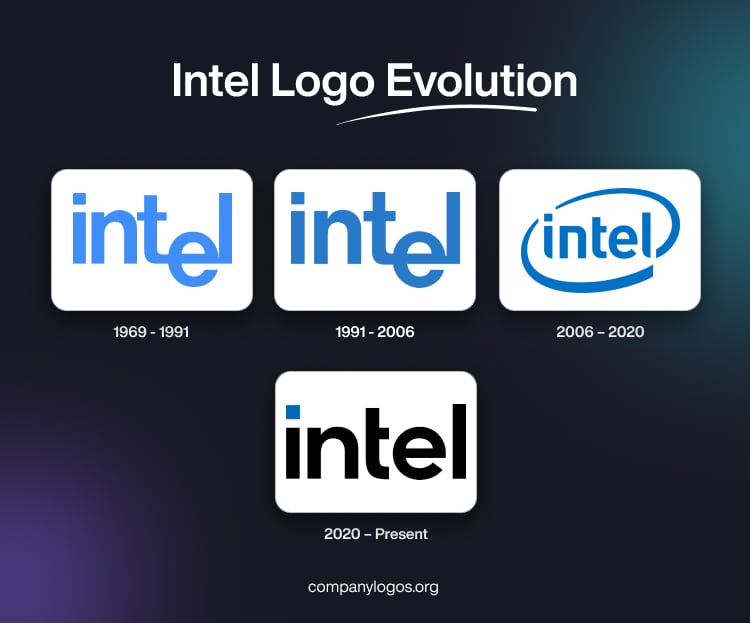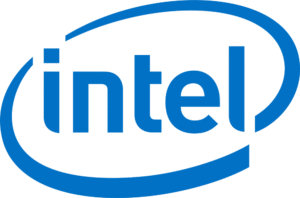
Intel is one of the world’s most influential technology companies that was founded in 1968. Based in the USA, the company produces an array of technological products that have revolutionised the world of computers. These include microprocessors, graphic processors, network cards, chipsets, and others. Intel has maintained a strong and evolving visual identity since its founding. It changed over time, and each change reflects shifts in the tech landscape and Intel’s ambitions. The article delves into the history and evolution of the Intel logo, among other details.
The Genesis of the Intel Logo (1969 – 1991)
When Intel was founded by Robert Noyce and Gordon Moore, the original logo was designed to embody both simplicity and innovation. This logo, trademarked on March 11, 1969, featured a clear, modified Helvetica bold, sans-serif font with a distinctive twist: the letter “e” was dropped below the baseline. This created a visual cue that conveyed the company’s willingness to break conventions and think differently. The logo was rendered in a light blue colour, a choice that would become a hallmark of the brand. It symbolised trustworthiness and technological prowess.

(1991 – 2006)
In the 1991 logo edition, the original logo design was retained, but the colour shade was changed to a darker one. During this time, Intel also launched the “Intel Inside” campaign. This move was part of a strategic marketing effort to make consumers aware of the value of Intel processors in their computers.

(2006 – 2020)
In 2005, Intel underwent a significant rebrand to modernise its image and align with its expanding portfolio. The new logo, which was designed with the help of FutureBrand, drew inspiration from the successful “Intel Inside” campaign. Accordingly, the wordmark was updated, the letter “e” was brought in line with the other letters, and the entire word was encircled by a sleek, elliptical swoosh. This design symbolised movement, dynamism, and Intel’s forward-looking vision.
The blue palette was retained to ensure continuity and trust, while the new tagline “Leap Ahead” was introduced to signal Intel’s commitment to innovation and leadership in technology. This era also saw the introduction of a more geometric, slightly squared font called ‘Neo Sans Intel to emphasise modernity and precision.

(2020 – Present)
In 2020, Intel unveiled its most significant redesign in over a decade. This new design by Andrew Mirakian of VMY&R reflects the evolution of the company into a broader technology leader. The new logo stripped away the swoosh and embraced a minimalist, geometric wordmark in black and blue. The typeface used to write the brand name was a custom sans-serif one called Intel One. It was designed to reflect modernity, clarity, and approachability. Also, the dot over the letter “i” is now a square. It was redrawn to symbolise the microchips at the heart of Intel’s business and represents the potential and power of Intel processors.

The Elements of the Intel Logo
Font
The wordmark used in the Intel logo is written using a custom sans-serif typeface. The letter “i” has a square on its top, instead of the conventional round dot. Besides, the horizontal bar of the letter “t” is smaller.
Colour
The Intel logo uses a light blue shade for the square placed above the letter “i.”. For the rest of the letters, black is used as the primary colour against a white background.
The History of Intel
Intel Corporation holds an important position in the global technology industry and is renowned for its key role in the development of semiconductors and microprocessors. Since its founding in 1968, Intel has been at the forefront of innovation. It has virtually shaped the personal computing revolution and driven advancements in electronics.
Intel was founded on July 18, 1968, in Mountain View, California, by semiconductor pioneers Gordon Moore and Robert Noyce, with financial backing from investor Arthur Rock. Both Moore and Noyce were former employees of Fairchild Semiconductor and were part of the legendary “traitorous eight” who helped launch Silicon Valley’s tech boom. The company’s initial focus was on developing semiconductor memory products to replace magnetic-core memory with faster, more reliable alternatives.
Intel’s first product was the 3101 Schottky TTL bipolar 64-bit static random-access memory (SRAM) chip in 1969, which was followed by the 1101 MOSFET SRAM and the 1103 dynamic random-access memory (DRAM) chip. The latter became the world’s bestselling semiconductor memory by 1972. Intel’s most significant breakthrough came in 1971 with the introduction of the world’s first commercial microprocessor, the Intel 4004. This innovation laid the groundwork for the modern computing era. Intel’s processors also became the standard for IBM PCs and their clones.
Throughout the 1980s and 1990s, Intel continued to innovate with the release of the 286, 386, 486, and the iconic Pentium processors. The company’s partnership with Microsoft, known as the “Wintel” alliance, was instrumental in shaping the PC industry. Here, Intel supplied the hardware, and Microsoft provided the software. By the mid-1990s, Intel had achieved a dominant market share in PC microprocessors and reached 90% at its peak.
Intel’s aggressive investment in new designs and manufacturing processes fuelled the rapid growth of the computer industry. In the 2000s, Intel expanded beyond traditional CPUs and introduced products for servers, mobile devices, and embedded systems. These included the first 1-gigahertz processor and the Pentium 4, the Itanium, Intel’s first 64-bit processor, and the release of Centrino technology, which made wireless connectivity a standard in laptops.
In 2006, Intel introduced the Core microarchitecture, including dual-core and quad-core processors. In 2011, it unveiled the “Tri-gate” 3D transistor, again a major leap in chip design. Intel also ventured into new markets, such as wearables, artificial intelligence, and autonomous vehicles, and acquired companies like Mobileye to bolster its capabilities.
Intel has continued to innovate by introducing advanced processors like the Core i7, i9, and Xeon Scalable series, as well as low-power chips for mobile devices (Intel Atom). The company faced challenges from competitors, notably AMD and ARM-based chipmakers, and navigated industry shifts such as Apple’s decision to use its own chips in Mac computers. Intel has also tackled security vulnerabilities like Spectre and Meltdown and invested in next-generation technologies, such as quantum computing and AI accelerators.
Interesting Facts About Intel
- Intel was founded in 1968 by Gordon Moore (a chemist) and Robert Noyce (a physicist). Both of them were prominent figures in the semiconductor industry.
- The company’s name is a contraction of “Integrated Electronics”. It was initially called NM Electronics before acquiring the rights to “Intel”.
- Gordon Moore is famous for “Moore’s Law”, which predicted the number of transistors on a chip to double approximately every two years.
- Moore first proposed this in 1965, and it has guided Intel’s development strategy for decades.
- Intel introduced the world’s first commercially available microprocessor, the Intel 4004, in 1971. This chip revolutionised computing by miniaturising the central processing unit. It enabled smaller and more affordable computers.
- Before microprocessors, Intel’s primary business used to be memory chips. For instance, the 1103 DRAM, released in 1970, became the world’s bestselling semiconductor memory chip by 1972. It replaced the magnetic core memory in many applications.
- Intel’s “Intel Inside” marketing campaign, which was launched in 1991, made the company a household name and helped consumers recognise the value of having Intel chips in their PCs.
- By the late 1990s, Intel’s Pentium processors had become synonymous with personal computing.
- Intel was an early adopter of the office cubicle layout. It popularised the “office honeycomb” that became a standard in corporate America. Even high-level executives, including former CEO Paul Otellini, worked in cubicles.
- Intel employs over 100,000 people worldwide, with about half based in the United States.
- The company has manufacturing and development centres in countries including Malaysia, Singapore, Israel, China, India, and Costa Rica, where its facility once accounted for 20% of Costa Rica’s exports and 5% of its GDP.
- The cleanroom areas in Intel’s chip fabrication plants are thousands of times cleaner than a typical hospital room. These ensure the integrity of semiconductor manufacturing.
- Intel uses a “tick-tock” model for processor development. The “tick” phase introduces new manufacturing processes, while the “tock” phase delivers new microarchitectures. This approach has kept Intel at the forefront of innovation.
- Intel invests billions annually in research and development (e.g., $5.7 billion in 2008 alone).
- The company has acquired firms like McAfee (for security), Infineon’s Wireless Solutions, Altera (for programmable chips), and Mobileye (for autonomous driving technology).
- In 2003, it was estimated that Intel shipped about 10 quintillion (10,000,000,000,000,000,000) transistors per year, which was about 100 times the estimated number of ants on Earth.
- The price of a single transistor on a chip is roughly equivalent to the cost of a printed newspaper character.
- Intel has contributed to charitable causes and public art as well. These include designing a Paddington Bear statue for auction in London to benefit the NSPCC.
Finally
The Intel logo and its various iterations are a testament to the company’s ability to adapt and lead in a rapidly changing industry. It began with the rebellious “dropped-e” to the sleek swoosh and now the minimalist, geometric design. Each logo iteration has captured the spirit of its era while maintaining the core values of innovation, reliability, and forward-thinking.